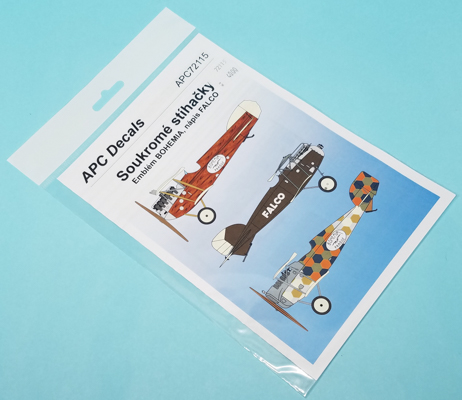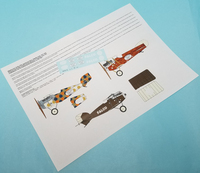
APC Decals 1/72 Soukromé Stíhačky
By Matt Bittner
Overview
After World War I, a number of fighters ended up in private hands and this set of decals covers three of them. For kits, the Phönix D.II was available in injected plastic from MAC Distribution (unsure if it's still in production); the Albatros D.II is/was available from Roden and Pegasus in injected plastic, and Choroszy and HR Model in resin; and the Aviatik Berg D.I was/is available from Toko/Eastern Express and Aeroclub, resin from Choroszy and a vacuum-formed kit from Classic Plane.
The Decals
This set covers three post-World War I fighters (with translation from Google):
- Albatros D.II, 53.05, ČSR, společnost Falco, Zdeněk Lhota, 1921-1922 (Albatros D.II, 53.05, Czechoslovakia, Falco company, Zdeněk Lhota, 1921-1922)
- Phönix D.II, 322.03, ČSR, aviatické sdruženi Bohemia, R. Polanecký, srpen 1922 (Phönix D.II, 322.03, Czechoslovakia, aviation association Bohemia, R. Polanecký, August 1922)
- Aviatik Berg D.I, 138.114, aviatické sdruženi Bohemia, cca 1921-1922 (Aviatik Berg D.I, 138.114, aviation association Bohemia, approx 1921-1922)

|
The decals are very nicely printed and appear to be in register. Here's how they are finished, taken directly from the instructions:
- Albatros D.II probably had the fuselage, vertical stabilizer, upper surfaces of the wings and horizontal stabilizator and elevator painted in dark color, perhaps brown. The bottom surfaces of the wings, elevator and rudder remained in clear doped linen color. The metal parts, engine covers etc. remained in the metal color. The original A-H insignias were covered by white paint on the bottom wing. Although it was Oeffag version 53, the nose was modified to version 253 shape.
- The Phönix aircraft was probably in the original color of the material, wings and tail surfaces in the color of the clear doped linen, the wooden parts then in the color of the wood. On some photographs, the fuselage shows signs of repairs. The metal parts, engine covers etc. remained in the metal color. How the original designation was removed from the surfaces or whether these were newly coated is unfortunately not known from the published sources.
- Berg D.I had an Austrian equivalent of "lozenge", the upper and side surfaces covered with hexaons in several basic colors, the lower surface apparently remiaining in the canvas color. How the original designation was removed is unknown. In a certain period Berg had only the unfinished mark of Bohemia, a white ellipse.
These are a nice alternative to the "usual" World War I finish of these fighters.
My thanks to APC Decals for supplying this review set.
